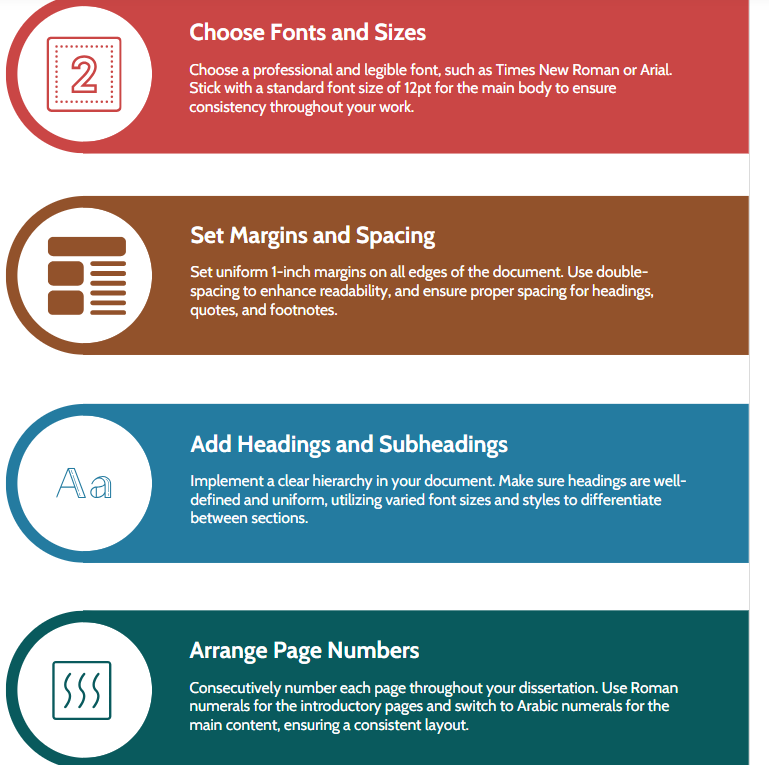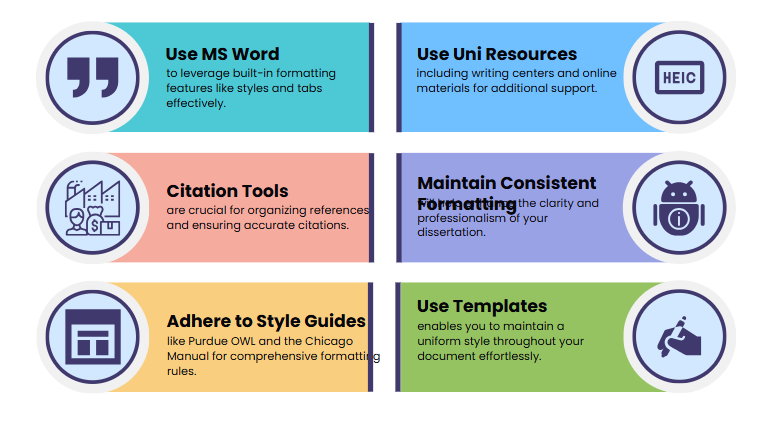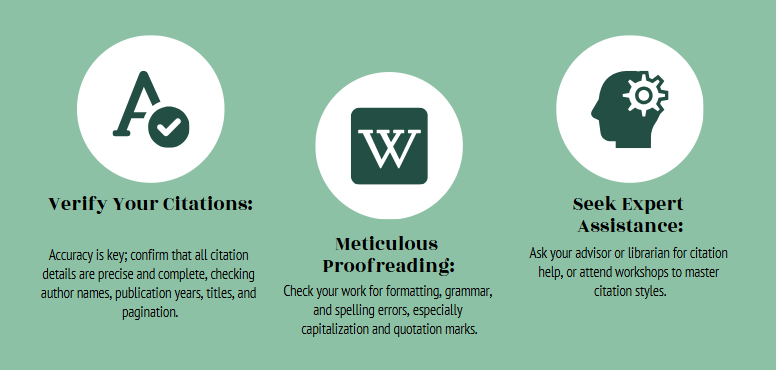The dissertation, the culmination of years of research and academic effort, is a monumental undertaking. But even the most insightful research and compelling arguments can be overshadowed by poor formatting. Mastering dissertation formatting is not merely a matter of aesthetics; it ensures clarity, readability, and adherence to academic standards, ultimately reflecting your professionalism and the quality of your work.
The Foundation of Dissertation Formatting: Style Guides and Templates
The first step in achieving impeccable dissertation formatting is choosing the right style guide and utilizing appropriate templates. Style guides, like the Modern Language Association (MLA), American Psychological Association (APA), or Chicago Manual of Style, dictate specific rules for formatting elements like citations, headings, and page numbers. These guides are often dictated by your university or department, so be sure to check with your advisor for the specific requirements.
The Power of Templates: A Head Start on Formatting
Templates provided by your university or software programs can significantly streamline your formatting process. These pre-designed templates ensure you adhere to the chosen style guide's specifications for margins, fonts, and page layout. Using a template saves you time and eliminates the potential for inconsistencies throughout your dissertation.
Key Elements of Effective Dissertation Formatting
1. Fonts and Font Sizes: Choose a font that is easy to read and adheres to your style guide's recommendations. Times New Roman, Arial, and Cambria are commonly used for academic writing. Use a clear font size, usually 12pt for the main body text, for optimal readability. Avoid overly decorative or stylized fonts that can detract from the professionalism of your work.
2. Margins and Spacing: Maintain consistent margins throughout your dissertation, typically set at 1 inch on all sides. Double-space between lines of text, except for headings, block quotes, and footnotes. Proper spacing enhances readability and gives your work a polished look.
3. Headings and Subheadings: Use a hierarchical structure of headings and subheadings to break up your text and guide the reader. Ensure that headings are clear, concise, and consistent with your chosen style guide. Use different font sizes and styles to distinguish between different levels of headings, further enhancing readability.
4. Page Numbers and Pagination: Number all pages of your dissertation consecutively, starting with the title page. Use Roman numerals for preliminary pages (e.g., table of contents, abstract) and Arabic numerals for the main text. Ensure that page numbers are placed consistently, usually in the top right corner or the bottom center of the page.
5. Citations and References: Accurate and consistent citations are crucial for academic integrity. Follow your chosen style guide's rules for formatting in-text citations and references. Use citation management software to ensure accuracy and avoid potential errors.
6. Tables and Figures: Tables and figures should be properly labeled and referenced in the text. Ensure they are visually appealing and easy to understand. Include captions that clearly explain the content of each table or figure.
7. Tables of Contents, List of Figures, and List of Tables: Include these components as needed, formatted according to your style guide. These lists help the reader navigate your dissertation and locate specific information easily.
8. Abstract and Acknowledgements: The abstract, a brief overview of your research, should adhere to word count limitations and concisely summarize your key findings. Acknowledgements express gratitude to those who have contributed to your work.
9. Appendix and Bibliography: The appendix contains supplementary materials, such as raw data or questionnaires. The bibliography lists all the sources cited in your dissertation, formatted according to your chosen style guide.

Tips for Successful Dissertation Formatting
1. Start Early: Don't wait until the last minute to begin formatting. Start early to avoid last-minute stress and ensure that your formatting is consistent throughout.
2. Use a Checklist: Create a comprehensive checklist that outlines all essential formatting elements. This checklist ensures you don't miss any crucial details and helps you maintain consistency.
3. Proofread Carefully: Once your dissertation is formatted, proofread it meticulously for errors in formatting and grammar. Ask a trusted peer or friend to review your work for additional feedback.
4. Use a Professional Editing Service: Consider using a professional editing service to review your dissertation for formatting and grammar errors. These services provide a fresh perspective and can help you catch any oversights.
5. Seek Guidance from Your Advisor: Your dissertation advisor is your most valuable resource for formatting questions. Consult with them regularly throughout the process to ensure you are adhering to all departmental and university guidelines.
The Importance of Professional Dissertation Formatting
1. First Impressions Matter: Dissertation formatting plays a crucial role in presenting your research in a professional and polished manner. Clear and consistent formatting creates a positive first impression on readers, highlighting the quality of your work.
2. Enhanced Readability: Effective dissertation formatting significantly improves readability, allowing readers to focus on your content rather than struggling with distractions or inconsistencies. This enhances the impact of your research and strengthens your arguments.
3. Academic Integrity: Following established formatting guidelines demonstrates your adherence to academic standards and reflects your understanding of scholarly conventions. This is essential for maintaining academic integrity and building trust with readers.
4. Facilitating Assessment: Consistent formatting allows your dissertation to be evaluated effectively and fairly. Readers can readily assess your work's quality when they are not distracted by formatting inconsistencies or errors.
5. Professionalism and Credibility: Meticulous dissertation formatting projects an air of professionalism and credibility. It demonstrates your attention to detail and commitment to producing high-quality academic work.
Dissertation Formatting: A Continuous Process
Dissertation formatting is not a one-time event. It's a continuous process that begins as you start writing and continues until the final submission. Regularly reviewing and refining your formatting ensures consistency and minimizes the need for last-minute revisions.
Tools to Enhance Your Dissertation Formatting
1. Microsoft Word: Word processing software like Microsoft Word offers numerous formatting tools and templates that streamline the formatting process. Utilize features like styles, tabs, and the "Find and Replace" function to maintain consistency.
2. Citation Management Software: Programs like EndNote, Zotero, and Mendeley simplify citation management and automatically format citations and bibliographies according to chosen style guides.
3. Online Style Guides: Websites like Purdue OWL and the Chicago Manual of Style offer comprehensive guidelines and resources for dissertation formatting.
4. University Resources: Most universities offer helpful resources, including writing centers and online formatting guides, to assist students with dissertation formatting.

Common Mistakes to Avoid in Dissertation Formatting
Your dissertation is the culmination of years of research and hard work. You've meticulously crafted arguments, analyzed data, and developed a compelling narrative. But even the most brilliant research can be overshadowed by careless dissertation formatting.
Dissertation formatting goes beyond mere aesthetics. It serves as a roadmap for your reader, ensuring clarity, consistency, and professionalism. Failing to adhere to established guidelines can detract from the quality of your work and leave a negative impression on your committee. To avoid this, be aware of these common pitfalls:
1. Neglecting Style Guide Requirements: Every academic discipline has specific formatting standards. Be it APA, MLA, Chicago, or another style guide, adhering to its rules is crucial. Ignoring these guidelines can result in inconsistencies in citation format, headings, margins, and other elements, making your work appear sloppy and unprofessional.
2. Inconsistent Font and Spacing: Choose a clear, readable font like Times New Roman or Arial, and stick to it throughout your entire dissertation. Ensure consistency in font size and spacing for headings, subheadings, and body text. Avoid using multiple fonts or inconsistent spacing, as it can be jarring for the reader and make your work look amateurish.
3. Misaligned Margins and Pagination: Setting appropriate margins and consistent pagination are essential. Failing to do so can create an unorganized and cluttered appearance. Use the specified margin settings for your chosen style guide and maintain a uniform page numbering system, preferably with Roman numerals for the preliminary pages and Arabic numerals for the main text.
4. Ignoring Page Numbering and Headers: Proper page numbering is crucial for navigating a long document like a dissertation. Make sure each page, including preliminary pages like the table of contents, has the appropriate page number. Similarly, headers or running heads should be used consistently to provide context and ease navigation.
5. Unclear and Inconsistent Headings: Headings and subheadings are essential for organizing your dissertation and guiding the reader through the flow of your arguments. Use clear, concise language for headings and adhere to the hierarchical structure defined by your style guide. Inconsistent formatting or overuse of bolding and underlining can lead to a cluttered and confusing reading experience.
6. Overlooking Tables and Figures: Tables and figures are valuable tools for presenting data and supporting your arguments. However, their formatting is crucial. Ensure they are properly labelled, captioned, and integrated into the text. Avoid using too many tables or figures, as this can overwhelm the reader.
7. Missing References and Citation Errors: Accuracy and consistency in referencing and citations are crucial for academic credibility. Carefully proofread your citations and bibliography to ensure they are in the correct format and accurately reflect your sources. Missing or incorrect citations can raise serious questions about the originality and reliability of your work.

8. Skipping Proofreading: No matter how meticulous you are, errors can creep in during the writing process. Thorough proofreading of your dissertation is crucial to catch any typos, grammatical errors, and formatting inconsistencies. If possible, ask a trusted colleague or friend to proofread your work for an objective perspective.
Dissertation formatting is often seen as a tedious task, but it's vital to your success. By carefully considering and addressing the common mistakes listed above, you can present a professional and polished dissertation that reflects the quality of your research and makes a strong impression on your committee. Remember, a well-formatted dissertation enhances your work's readability and strengthens your arguments, contributing to a positive impression and a successful defense.
The Power of Professional Dissertation Formatting
Mastering dissertation formatting is an essential step in creating a powerful and impactful document. By following the guidelines outlined above, you can ensure that your dissertation reflects the quality of your research, enhances its readability, and projects a professional image. Remember, dissertation formatting is not just about aesthetics; it's about ensuring the clarity, accuracy, and effectiveness of your work, ultimately contributing to its success and your academic achievement.
Get Professional Dissertation Formatting Service
At Exemplary Dissertations, we offer professional dissertation writing services for PhD and Master’s. We guarantee an all-inclusive service that also covers topic suggestion, proofreading, editing, formatting and plagiarism removal. Besides dissertations, we can also assist you with writing research papers, essays and case studies.